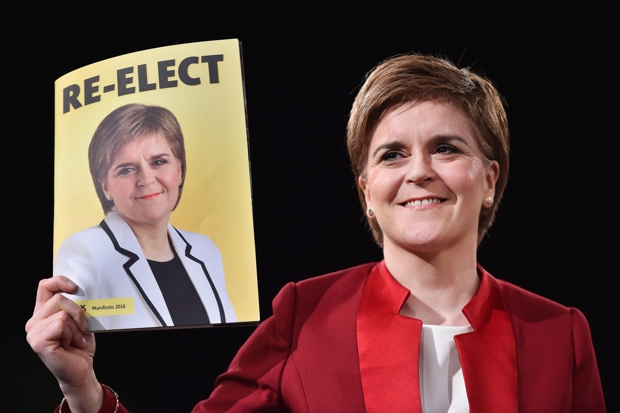Do you want to know what it looks like when one party has become the most dominant force in its country’s political history, when one in every 30-odd voters is a member of that party and when it is regularly topping 50 per cent in the polls?
Then look no further than central Edinburgh this morning where Nicola Sturgeon was launching the SNP’s Holyrood election manifesto.
The queues to get in to the Edinburgh International Conference Centre stretched back for several streets as supporters and party members waited eagerly in the warm spring sunshine for the chance to hear, and see, their leader in person.
The inside of the hall was arrayed like an American political convention with the SNP leader speaking in the centre of 1,400 supporters in four tiered banks of seats – political theatre in the round, you might say. The American influence didn’t end there, with ‘I’m with Nic’ yellow wristbands given out and an interactive app ready to download for all those present.
The leader’s speech was not just beamed above the podium on a four-sided screen for all to see but all those who couldn’t make it could watch live on the SNP’s own YouTube channel.
This wasn’t a usual manifesto launch where the leader appears before the media, makes a short speech and answers questions. This was effectively a carefully-staged and well-prepared mini-conference, a rally to grab airtime and project supreme political confidence with polling day just ten days away. Indeed, this was a party with 115,000 members, deep pockets and an unassailable poll lead showing just how powerful it was.
The manifesto itself made no excuses for its unashamed promotion of the central figure. There was one word ‘Re-elect’ on the front cover above a huge picture of Ms Sturgeon with just the words ‘SNP manifesto 2016’ written in small letters at the bottom. But for those of us who have studied SNP manifestos for the past 20 years, there was something different in tone and approach this time round.
Every manifesto since devolution in 1999 has promised a referendum on independence. Not this time. This year independence is there but it is cautiously advocated with the manifesto suggesting that a fresh referendum could be held if the people demand it or if there is a material change in circumstances (ie Brexit).
Ms Sturgeon did tackle this issue head on in her speech, attempting to pacify the critics from her own side who want to move forward on independence, with the wary voters outside who remain sceptical. She declared:
‘If there is to be a second referendum – whether that is in the next parliament or in a future parliament – we first have to earn the right to propose it. ‘Setting the date for a referendum before a majority of the Scottish people have been persuaded that independence – and therefore another referendum – is the best future for our country is the wrong way round. ‘So this summer, we will start new work to persuade a majority in Scotland of the case for independence. If we don’t succeed, we will have no right to propose another referendum. ‘But when we do succeed – (significantly, changed from ‘if’ in the text handed out to the media) when in the future there is clear and sustained evidence that independence has be-come the preferred option of a majority of the Scottish people – then no politician will have the right to stand in the way.’
So instead of being an old-fashioned rallying cry for freedom, this year’s manifesto appeared to be an appeal to voters to continue the status quo, asking the electorate to let the SNP manage the Scottish Government for another five years while embarking on a quieter, more measured campaign of soft indy persuasion at the same time.
And rather than independence being at the heart of the policy package, it was that old staple, the one issue which gets to voters more than any other – the NHS – which was the centrepiece.
The manifesto promised that a re-elected SNP administration would make above-inflation increases to the NHS budget in Scotland for every year of the next parliament and would then invest another £500 million over and above that.
The other key pledges included: doubling childcare to 30 hours a week for all three and four year olds and vulnerable 2 year olds, lifting 100,000 small businesses out of business rates completely, creating a new Scottish Social Security Agency ‘to make social security fairer’.
These next five years will see Scotland get almost complete control over income tax and a whole host of other key powers but you wouldn’t really know it from today’s presentation. There weren’t any radical ideas like whacking up taxes on the super-rich or introducing new tax bands.
Instead, the message from today was simple: the launch was slick, professional and powerful and it said to the voters – that is exactly what we will bring to government if you re-elect us. Given the polls, there isn’t much chance of the voters disagreeing.






Comments